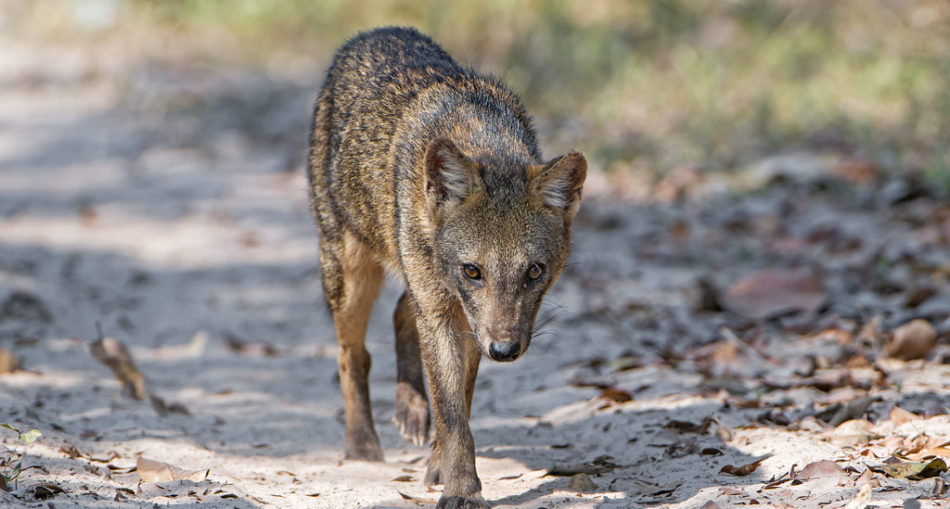Also known as the common fox, wood fox, and Savannah fox, the crab-eating fox (Cerdocyon thous) is a species of canid (dog family) that is found in South America (Guyana). They can live in most environments in South America except they avoid the rain-forests and extreme cold. This fox survives off a little bit of whatever, in the form of lizards, birds, rodents, eggs, fruit, tortoises, crustaceans, carrion, and crabs – hence, its name. It is also known to be easy to domesticate. This is perhaps due to its relation to the common domestic dog. In captivity, the crab-eating fox is known to live up to 11 years.
Continue to read to find out more about this uniquely amazing fox!
Scientific Classification Of The Crab-Eating Fox
- Kingdom: Animalia
- Phylum: Chordata
- Class: Mammalia
- Order: Carnivora
- Family: Canidae
- Genus: Cerdocyon
- Species: C. thous
There Are Five (5) Subspecies of the Crab-Eating Fox. They include:
- Cerdocyon thous thous – Venezuela, Guyana, Surinam, French Guiana & North Brazil.
- Cerdocyon thous azarae – North Brazil.
- Cerdocyon thous entrerianus – Brazil, Bolivia, Uruguay, Paraguay & Argentina.
- Cerdocyon thous aquilus – North Venezuela & Colombia.
- Thous germanus – Colombia.
Did you know?
- The name “thous” comes from Greek, and it means jackal. This obviously alludes to the fact that they resemble small jackals, and the genus label “Cerdocyon” in Greek translates to crafty dog.
- A young / baby of a crab-eating fox is called a ‘cub, kit or pup’. The females are called ‘vixen‘ and males ‘reynard, todd or dog‘. A crab-eating fox group is called a ‘leash or skulk‘.
Where Does The Crab-Eating Fox Live?
The Crab-eating fox lives in central South America. It ranges from Colombia, Guyana and Venezuela, and as far as Uruguay, Paraguay, and Northern Argentina. Its habitat mostly includes savannahs and woodlands; however, it is known to live in a range of other areas including edge and forested areas. It may prefer higher areas during the rainy season, moving to lowlands in the dry season.
What Does The Crab-Eating Fox Look Like?
The coat of the Crab-eating fox varies across its body. The back and sides are mixed with brown and gray which gives a yellowish tint. The underside of its coat is brownish white. The face, ears, and fronts of the legs are orange to brown or light brown in colour, while the tips of the ears and backs of the legs are black. The ears are short and the tail is long and bushy and is darkly pigmented or just the tip is black. The torso is rather narrow. Adults weigh from six to seven kilograms (6-7 kg), and they can range from 900 to 1000 mm in length from the head to the tip of the tail.
Diet And Nutrition Of The Crab-Eating Fox
The Crab-eating fox is an omnivore, mainly feeding on crabs, fish, reptiles, rodents, birds, insects, eggs and fruit. During the wet season, many will hunt for crabs on the floodplains. The species evolved as an opportunistic omnivore.
Habits And Lifestyle Of The Crab-Eating Fox
The Crab-eating fox is mainly nocturnal and is also active during dusk, spending the day in a den dug by other animals. These foxes travel together in pairs but hunt as individuals. In the dry season, these foxes have a tendency towards being more territorial than in the wet season, though overlap of territories often occurs. Hideouts and dens are often in thick grass and bushes, and each den usually has many entrance holes. Despite being capable diggers, the foxes prefer to take over the burrows of other animals. Hunting methods differ according to the type of prey. They make several characteristic sounds, including barking, howling and whining, when pairs of foxes lose contact. They raise their tails when they are excited and hairs when they are threatened. They also live in pairs composed of two animals of the opposite sex.
Reproduction Of The Crab-Eating Fox
Crab-eating foxes are monogamous. They often breed two times a year, 7 to 8 months apart, sometimes with a peak in births in January, February or sometimes March, and again in September to October. November or December is when the reproductive period usually begins, and again in July. Gestation lasts for 52 – 59 days, with females giving birth to 2 – 6 cubs. The fox cubs are born with their eyes and ears shut and without teeth. Their eyes open at around 14 days after birth. At 30 days they can start digesting solid food and at 3 months they are weaned. The sexual maturity is attained by the 1st year (according to studies), and in urinating, the raised leg (for both genders) action suggests sexual maturity.
Status Of Conservation Of The Crab-Eating Fox
Convention on International Trade in Endangered Species of Wild Fauna and Flora (CITES) lists the fox as not threatened by extinction; the IUCN lists the crab-eating fox as being of “Least Concern”.
About The Crab-Eating Fox
This fox can be seen along the road to Karasabai, Guyana. There are five (5) sub-species of the crab-eating fox that is found in South America. This species of fox is closely related to the common domestic dog and is known to be easy to domesticate. They mainly feed on CRABS, (hence its name) but also feeds on lizards, birds, eggs etc.
Article References:
- http://animalia.bio/crab-eating-fox
- https://www.ourbreathingplanet.com/crab-eating-fox/
- http://www.theanimalfiles.com/mammals/carnivores/fox_crab_eating.html
- https://thewebsiteofeverything.com/animals/mammals/Carnivora/Canidae/Cerdocyon/Cerdocyon-thous.html
- https://wikivisually.com/wiki/Crab-eating_fox
- Main Image: flicker- https://www.flickr.com/photos/tambako/29690702300







